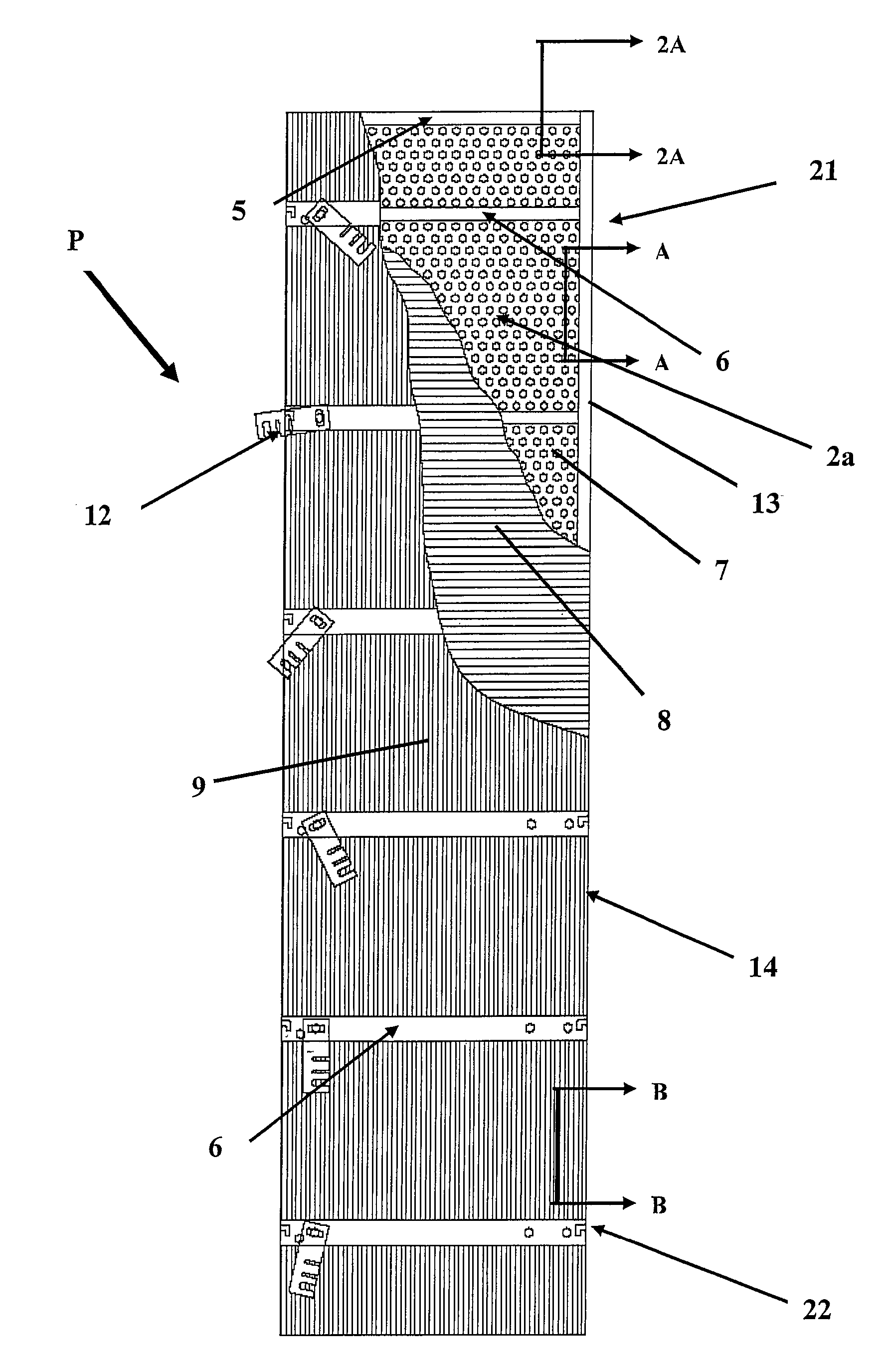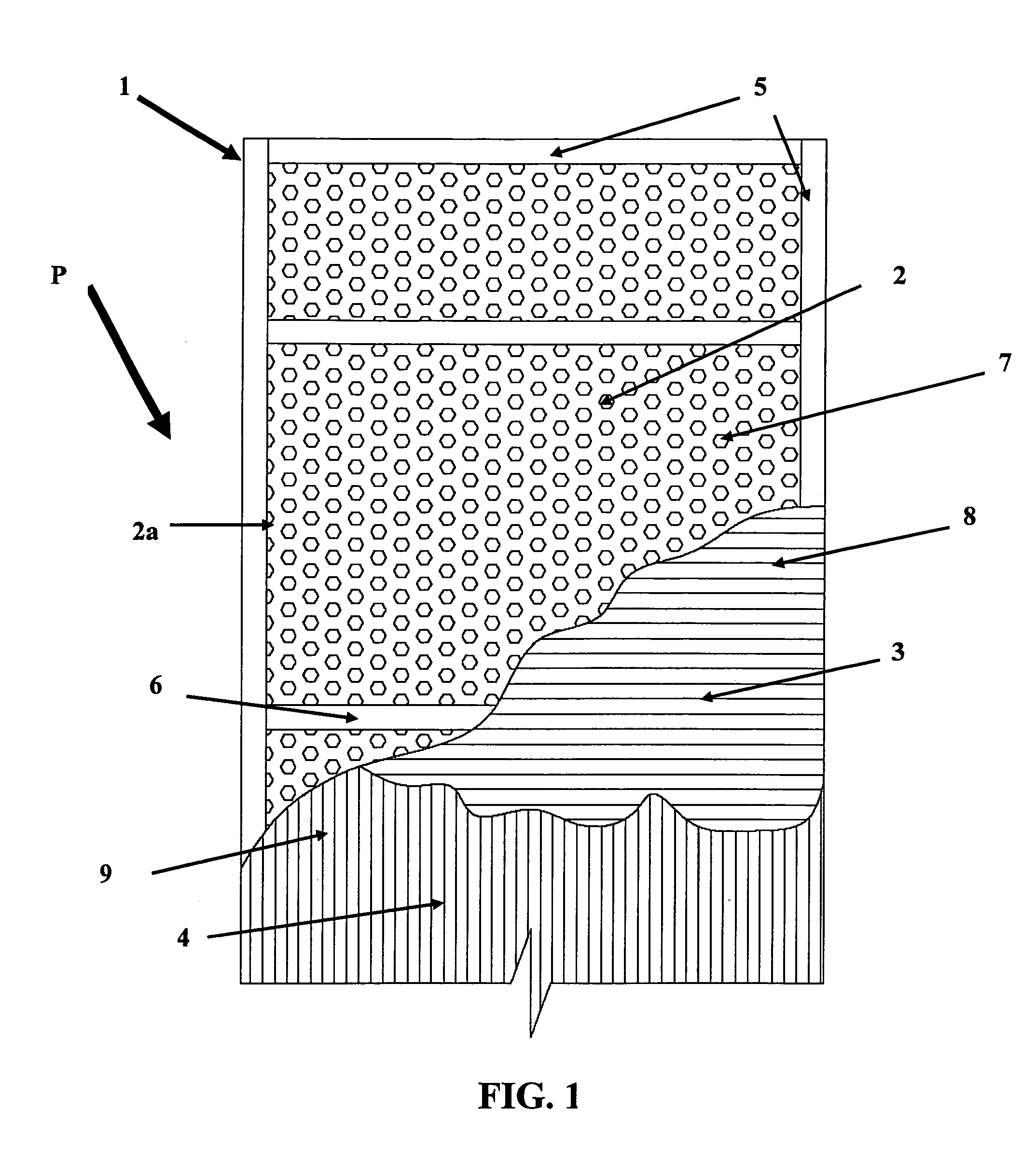Lightweight composite concrete formwork panel
a composite concrete and formwork technology, applied in the field of lightweight concrete formwork panels, can solve the problems of workplace lifting injuries, waste of time, and unnecessary use of more than one person, and achieve the effects of reducing weight, saving time and money, and speeding up the erection time of the formwork
- Summary
- Abstract
- Description
- Claims
- Application Information
AI Technical Summary
Benefits of technology
Problems solved by technology
Method used
Image
Examples
example i
Weight Comparison of Panel of the Invention Relative to an Industry Standard Panel
[0034]A conventional concrete pouring form, of the type standard in the industry, has an interior panel with steel connection hardware attached. The industry standard concrete pouring form has a width of 2 feet and a length of 8 feet, and has 6 ribs. This standard panel weighs about 80 pounds. The steel connection hardware for such a 2×8 form weighs about 25 pounds. Thus, the conventional interior panel weighs about 105 pounds.
Weight of Comparative Panel
[0035]According to one embodiment of the present invention, the lightweight composite panel P having a 2 feet by 8 feet size and 6 ribs weighs less than about 35 pounds. Adding 25 pounds for the steel connection hardware, the resulting total weight for the lightweight concrete formwork panel is about 60 pounds. This yields a 40% weight reduction in the total weight of the form, as compared to the industry standard, and a 55% weight reduction, as compare...
example ii
Assembly of a Lightweight Composite Panel
[0036]In one embodiment of the invention, the transverse and longitudinal reinforcements 3 and 4, respectively, are located on both sides of the exterior of the panel P and enclose a maple frame 1 and a lightweight balsa core 2. The lightweight core is composed of 1 in. thick end grain rigid balsa sheets.
[0037]The transverse skin reinforcements 3a and 3b comprise a fiber reinforced polymer which is applied to the first and second sides, respectively, of the maple frame 1 and the balsa core 2. In certain embodiments, the transverse skin reinforcements comprise an 11 oz / yd2 unidirectional E-Glass fabric which is oriented to provide strength across the width of the panel P.
[0038]The longitudinal skin reinforcements 4a and 4b comprise sheets of fiberglass-reinforced resin or plastic that are applied to the transverse skin reinforcements 3a and 3b, respectively. In certain embodiments, the longitudinal skin reinforcements 4a and 4b comprise two si...
example iii
Construction of Lightweight Composite Panel
[0040]The balsa core 2 and the maple frame 1 are cut to size according to the desired measurements. All connections are butt jointed and secured with standard wood glue. The transverse skin reinforcement, comprising 11 oz / yd2 unidirectional E-Glass fabric material, is cut into ten 24 in.2 sections for the transverse reinforcement. The transverse skin reinforcement is laid out on the balsa core-maple frame wood structure, oriented in the transverse direction with one 24 in2 layer on the upper 6 feet of the panel and two 24 in2 layers on the lower 2 feet of panel and then impregnated with a resin. Useful resins include an FPL-1 Epoxy resin and other epoxy resins. Non-epoxy resins can also be used.
[0041]The longitudinal skin reinforcement, comprising 12 in. wide 0.02 in. thick unidirectional fiberglass-reinforced resin or plastic hard laminate sheet material, is cut to 96 in. lengths. The resin impregnated transverse skin reinforcement is cove...
PUM
| Property | Measurement | Unit |
|---|---|---|
| length | aaaaa | aaaaa |
| width | aaaaa | aaaaa |
| size | aaaaa | aaaaa |
Abstract
Description
Claims
Application Information
 Login to View More
Login to View More - R&D
- Intellectual Property
- Life Sciences
- Materials
- Tech Scout
- Unparalleled Data Quality
- Higher Quality Content
- 60% Fewer Hallucinations
Browse by: Latest US Patents, China's latest patents, Technical Efficacy Thesaurus, Application Domain, Technology Topic, Popular Technical Reports.
© 2025 PatSnap. All rights reserved.Legal|Privacy policy|Modern Slavery Act Transparency Statement|Sitemap|About US| Contact US: help@patsnap.com



